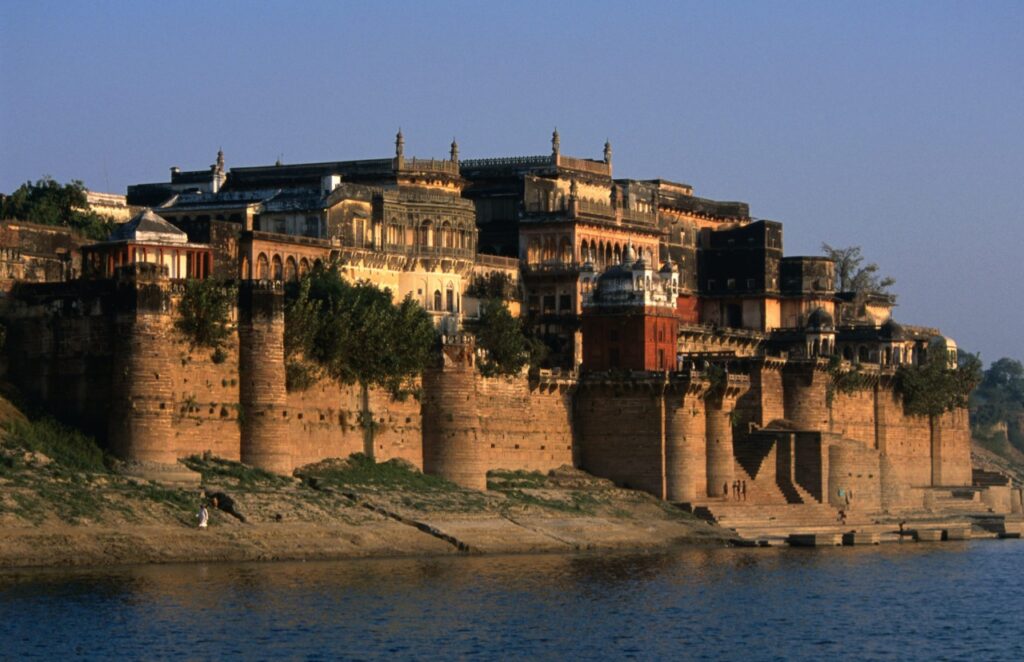
One of the oldest living city of India, Varanasi, formerly known as Banaras or Kashi, houses a variety of intangible as well as tangible heritage. The heterogeneous nature of the city attracts thousands of tourists all around the year. Situated amidst this assorted set up is the Ramnagar Fort. The architecture of the fort aptly embodies the essence of the Brahmin rulers who commissioned its construction. Apart from the grandiose of its architectural features, the fort is well known for the rich collection of antiquities housed in the Maharaja Banaras Vidya Mandir Museum. As the name suggests, the objects displayed in the museum are donations by every member of the royal family. The display rightly symbolizes the splendour of the late 18th and 19th century.
The museum is broadly divided into five galleries exhibiting- vintage cars and palanquins, textiles, arms and weapons, decorative collection and paintings and photographs. The halls and rooms of the fort appealingly accommodate and blend these galleries with the architecture and take the visitors back in the past!
The first gallery of the museum is dedicated to transport and houses vintage cars, palanquins and howdahs of elephants. The cars displayed in the gallery are- 1917 model of Minerva (designed in Belgium), USA made Cadillac of 1927, 1945 Buick (also USA designed) and many more. The cars were presented as gifts to the Maharajas from all parts of Europe and America. Along with vintage cars, the gallery has a wide collection of intricately ornamented palanquins. There are varieties of palanquins ranging from ones decorated with silk and brocade work to those that have khus curtains to provide freshness during summers. The one palanquin that stands out is – the lotus palanquin- that is made of silver and velvet and was used by the Maharaja. Horse and engine driven coaches are also displayed in this gallery of transports. Another major attraction in this gallery is meticulously carved ivory howdahs that maharajas traditionally used for hunting trips.
Continuing with the customary arc of the museum, the next gallery gives us an insight into the royal lifestyle. This gallery focuses on the attires of the royal family with remarkable displays of articles that were associated with the costumes. The item in focus in this gallery is Muslin from Dacca that is notably famous for its lightweight and finesse. The costumes on display include male dhotis with borders especially decorated with the purpose to conjoin planetary astronomy, caps and pagris decorated with salma and sitara. Complementing these apparels, are various kinds of musical instruments and huqqas. One of the rare types of huqqa displayed here is ‘Nariyal’ huqqa, which were often made out of coconut shells.
An armoury, or silahkhana, was a necessary adjunct of every princely state of India. The state of Varanasi also maintained a regular armoury employing several technicians who produced varieties of weapons that are displayed in the museum. The arms and weapon gallery showcase swords, arrows, spears and guns of various designs and make. One of the most important displays in this gallery is a sword that was gifted to the maharaja by Nawab Sujauddaulah of Oudh and by Lord Lytton, the Viceroy of India. Among firearms, there are some Mughal matchlocks inscribed with the names of their makers, a four-barreled pistol and an English flintlock pistol that was widely used by the sepoys for self-defence. Another significant exhibit is a rare long-barrelled Mauser, a German gun made in 1872 that was used during the First World War. The wide range of weapons presented in this gallery is symbolic of might of the unconventional Brahmin Maharajas of Banaras. The number of gifts and donations by the British East India Company to the fort is indicative of the weight of the vernacular rulers during the late 18th century.
The subsequent gallery that is the one that houses one of the most prized possessions and the main attraction of the Ramnagar Fort Museum – the Ramnagar Clock. B. Mulchand, the state clock-maker, built this distinctive instrument in the year 1872. The characteristic feature of this clock is that it gives a variety of chronological and astronomical information for which ordinarily several scientific pieces of equipment would be required. It demonstrates the correct time of the day along with the position of sun and phases of the moon. It shows zodiac signs, date of the month and the year. The clock ticks out the seconds and strikes the hours, half-hours and quarters. One of its unique features is that it requires winding once in eight days and the data is correctly calculated and regulated according to the geo-positioning of the Banaras City. Since 1923, the clock has been repaired and maintained under the supervision of B. Munnilal, artist of Banaras. This 19th-century scientific marvel is one of its kind and at par with European apparatuses of the period.
Apart from these major galleries, the museum exhibits wall paintings, portraits and photographs of the Maharajas and the royal court ceremonies. The portrait gallery has a sequence of paintings starting from a portrait of Raja Mansa Ram up till that of Maharaja Dr Vibhuti Narain Singh Bahadur. The next gallery is that of wall paintings depicting scenes of Mahabharata done in oil by Shiv Gulam and Jagarnath in early 20th century. Maharaja Banaras Vidya Mandir Museum is an embodiment of traditions and craftsmanship that has continuously construed the true flavour of Indian culture. It was built at a time when the perception of Indology was completely governed by the colonial ‘curio’ enthusiasts, that was only shaken by the grit of the lineage of Maharajas of Banaras. However, in today’s scenario, inapt administration and management of the museum has been acting as a hindrance for the growth of the museum. Despite the rich collection and a daily footfall of 1500 visitors, the museum has been unable to stretch to its potential. With proper maintenance and direction, the museum can engage people of all age and background.